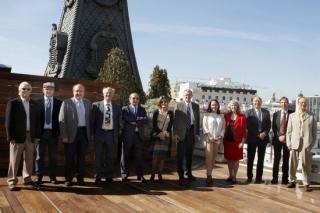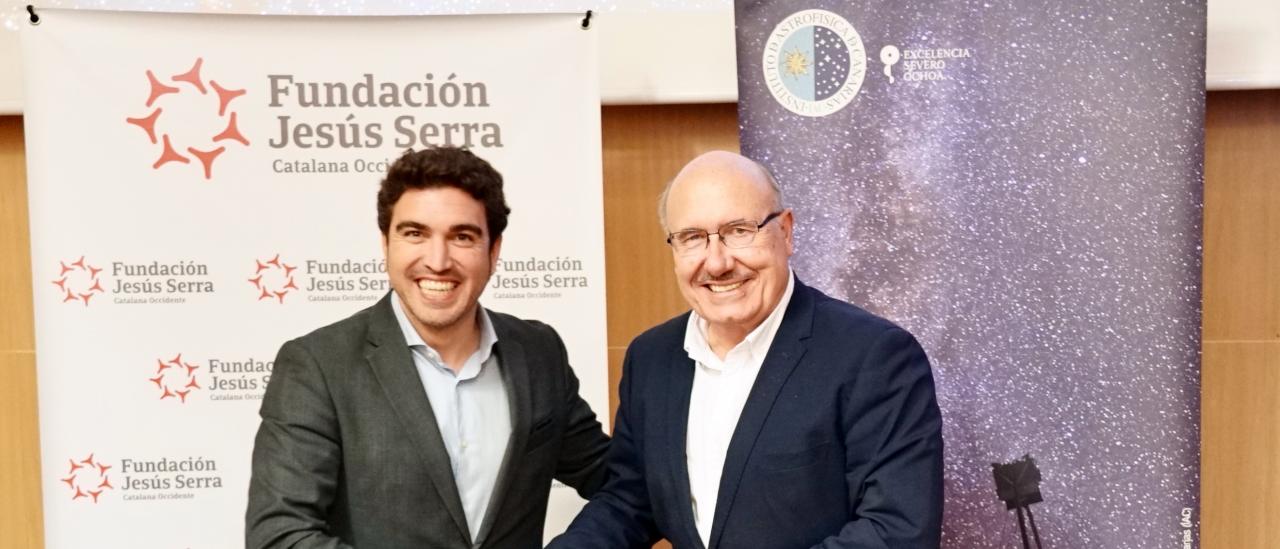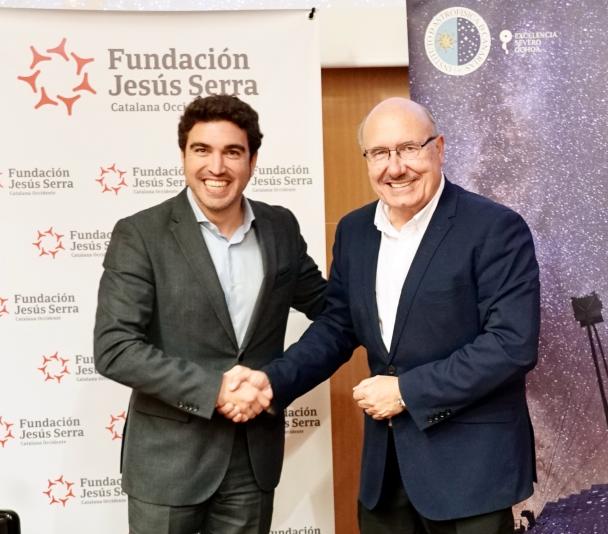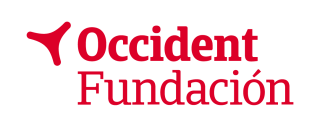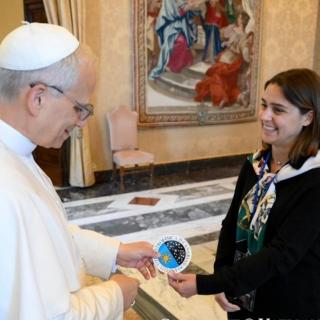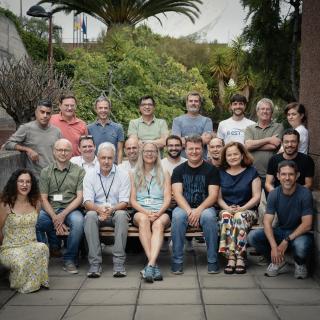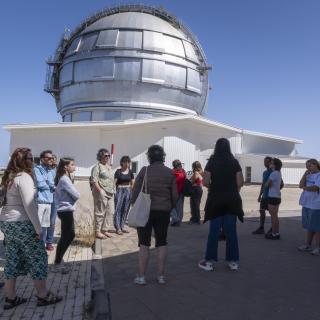The Jesús Serra Foundation and the Instituto de Astrofísica de Canarias have strengthened their relationship with a new agreement to formalize the collaboration between the two institutions in the Jesus Serra Foundation Visiting Researcher Programme . The aim of this programme is to attract highly prestigious international scientists to visit the IAC for stays of between one and three months. Representatives of the Foundation visited the IAC, the Teide Observatory (Tenerife ) and the Roque de los Muchachos Observatory (La Palma).
On Monday November 28th Ignacio Gallardo-Bravo, the Director General of the Jesús Serra Foundation and Rafael Rebolo, Director of the IAC, signed a new agreement for mutual collaboration in the Fundación Jesús Serra Visiting Researcher Programme. This agreement consolidates the relation between the two organizations, and renews the commitment to attract prestigious researchers to the IAC.
The agreement will be in place for three years and establishes a minimum stay of one month, reaching a limit of up to three months at the IAC for the chosen researchers. These stays will bring about stronger scientific relationships between the host research group and the visitor’s institution of origin, and will initiate new lines of activity based on new scientific interests. The programme also aims at reinforcing the IAC’s research activity and that of its associated technological projects, as well as starting new collaborative relations with institutions of recognized prestige in the field of astrophysics and space science.
In addition to the Director General of the Jesús Serra Foundation, its Deputy Director Susana Codina, and representatives of the Catalana Occidente Group at national and Canary level were also present. The IAC was also represented by Anselmo Sosa, the manager of the Office of Transfer and Institutional Activities, Alfonso López, the Coordinator of the Instrumentation Division, Jesus Falcón, the Research Coordinator, and representatives of the lines of research within the Severo Ochoa Programme.
During the signing ceremony, at the IAC Headquarters in La Laguna, Rafael Rebolo made a general presentation of the Institute, in which he summarised the status of research and of the technological projects under way, and he mentioned the new infrastructures planned for installation in the Canary Observatories.The Director of the IAC also thanked the Jesús Serra Foundation for its commitment to research, and for its “help in advancing science in the Canaries and in Spain.”
The Director General of the Foundation, Ignacio Gallardo-Bravo stressed that “collaboration with the IAC is a source of pride” and noted that the IAC is not only a centre for research, but also a motor for social change “in the Foundation we are convinced that without research there would be no social progress” he stated.
As well as the signing, during the meeting with visiting researchers, Vanessa Hill, Research Director at the CNRS (France) and Santi Cassisi, researcher at the INAF-Astronomical Observatory of Collurania (Italy) made presentations in which they explained the status of the work they are each doing during their stay at the IAC thanks to the Jesús Serra Foundation programme.
Visit to the Scientific Installations
During the day the representatives of the Jesús Serra Foundation and of the Catalana Occidente Group also took a tour of the IAC Headquarters in La Laguna. Afterwards they went to the Teide Observatory, where they were shown the many different types of telescopes by the Observatory Administrator Miquel Serra. They were also given the chance to make a solar observation by IAC outreach astrophysicist Alfred Rosenberg.
On Tuesday 29th the group travelled to the Roque de los Muchachos Observatory (ORM) where they werer received by the administrator Juan Carlos Pérez Arencibia. Next, they all went to the cherenkov telescopes (MAGIC and the LST) where Daniel Mazin, the manager of the LST project talked about the properties of these instruments, whose purpose is to detect high energy gamma-rays, and also about the Cherenkov Telescope Array (CTA), of which the LST is the first element, and which is under construction at the ORM.
Then they moved on to the GranTelescopio Canarias (GTC or Grantecan), where they learned some of the basic aspects of its working and the important discoveries being made thanks to the collecting power of its primary mirror, its sophisticated instruments, and the hard work of its specialized personnel.
Almost a decade of collaboration
Collaboration between the two institutions began in 2014, coinciding with the first period for the IAC of declaration as a Severo Ochoa Centre of Excellence, a standard of excellence granted by the Spanish government in order to recognize, reward, and promote research in the scientific centres, and units, with high scientific level and international prestige.
Since then, within the framework of this programme of visiting researchers, the Severo Ochoa Coordinating Committee (CCSO) within the IAC, whose role is the coordination, management, and follow-up of the Severo Ochoa Programme, is also the committee which proposes to the Jesús Serra Foundation a list of possible researchers and visiting professors, which is subsequently approved and incorporated into the mobility programme.
From the start of the collaboration, 35 scientists have already participated in the programme. During the latest period of the programme in 2021 and 2022, as well as Vanessa Hill and Santi Cassisi, others who have benefited have been Henri Boffin, Cristina Chiappini, Minia Manteiga, Evanthía Hatziminaoglou, Angel Ricardo Plastino, Brian Welch, Axel Brandenburg, Eva Villaver, Vhyacheslav (Slava) Lukin, Faith Vilas, Norbert Langer, Sebastián Sánchez and Diego Blas.
More information:
Jesús Serra Foundation web page about new visiting researchers
